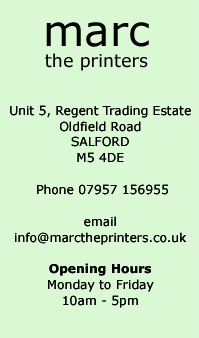Problems specific to the spot colour risograph and soya inks
1. Not suitable for the spot colour risograph
Because the spot colour risograph uses wet ink pushed through the holes
in a screen (putting it very simply!), not everything can be printed successfully
using this method. The following will cause problems: large areas of solid
coverage, very fine detail, very small text, pictures that lack definition,
solid areas near the edge of the artwork etc. If in doubt, discuss a spot
colour risograph job with us before committing yourself to a design. (see
"laser printing")
2. Using an extra colour
In order to print your two-colour work on the spot colour risograph, we
must be able to separate the colours in your artwork (you need to provide
"colour separations"). This is because we print one colour first,
then put the paper through the printer again to print the second colour.
(see "registration"). Please show us your design in plenty of
time so that any problems can be resolved - not every design can be successfully
printed on the spot colour risograph.
Note: there are a limited number of soya ink colours available (see "ink
colours"). Also, the soya inks are semi-transparent, so putting one
colour on top of another rarely works as it will usually produce a mucky
brown!)
3. Registration (or lining up colours)
When we print your two-colour work on the spot colour risograph, we print
one colour first and then put the paper through the machine again to print
the second colour. Because the machine is friction fed, the paper will not
go through the machine in exactly the same place as the first pass, and
there may also be the possibility of a slight twist developing if there
is uneven ink coverage across the paper. For this reason this printing method
is not good for anything where the two colours need to line up exactly (perfect
registration). Please keep this in mind when designing artwork for the spot
colour risograph that involves more than one colour
Back to How to send us artwork












